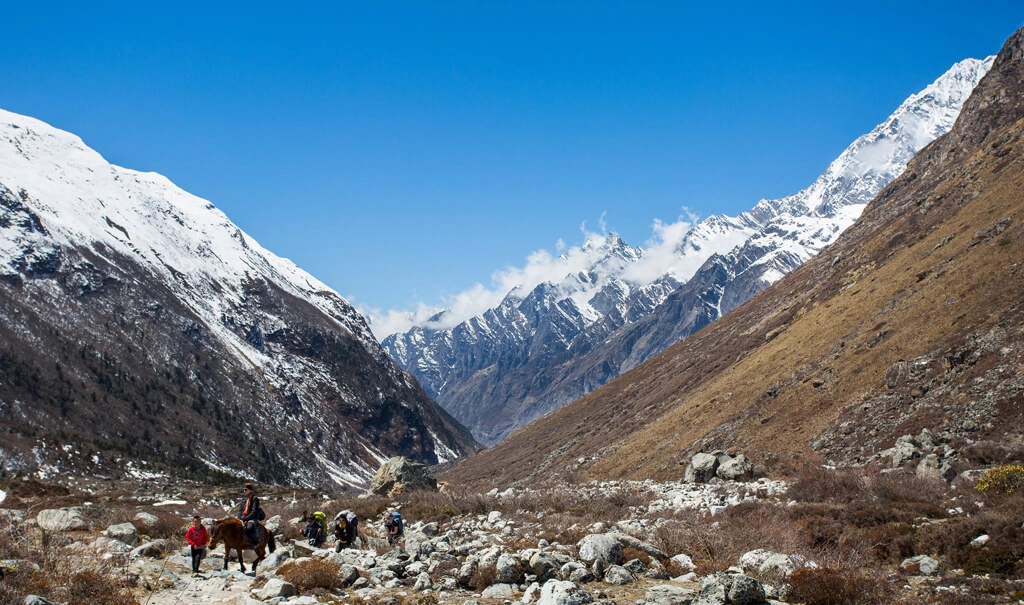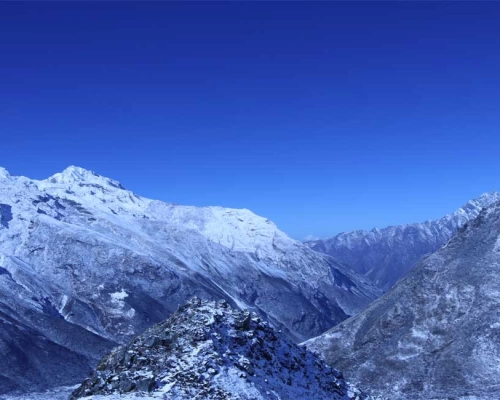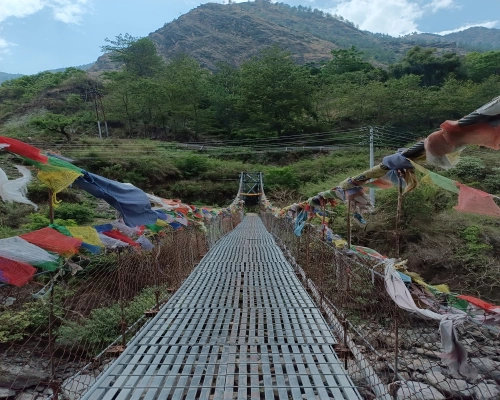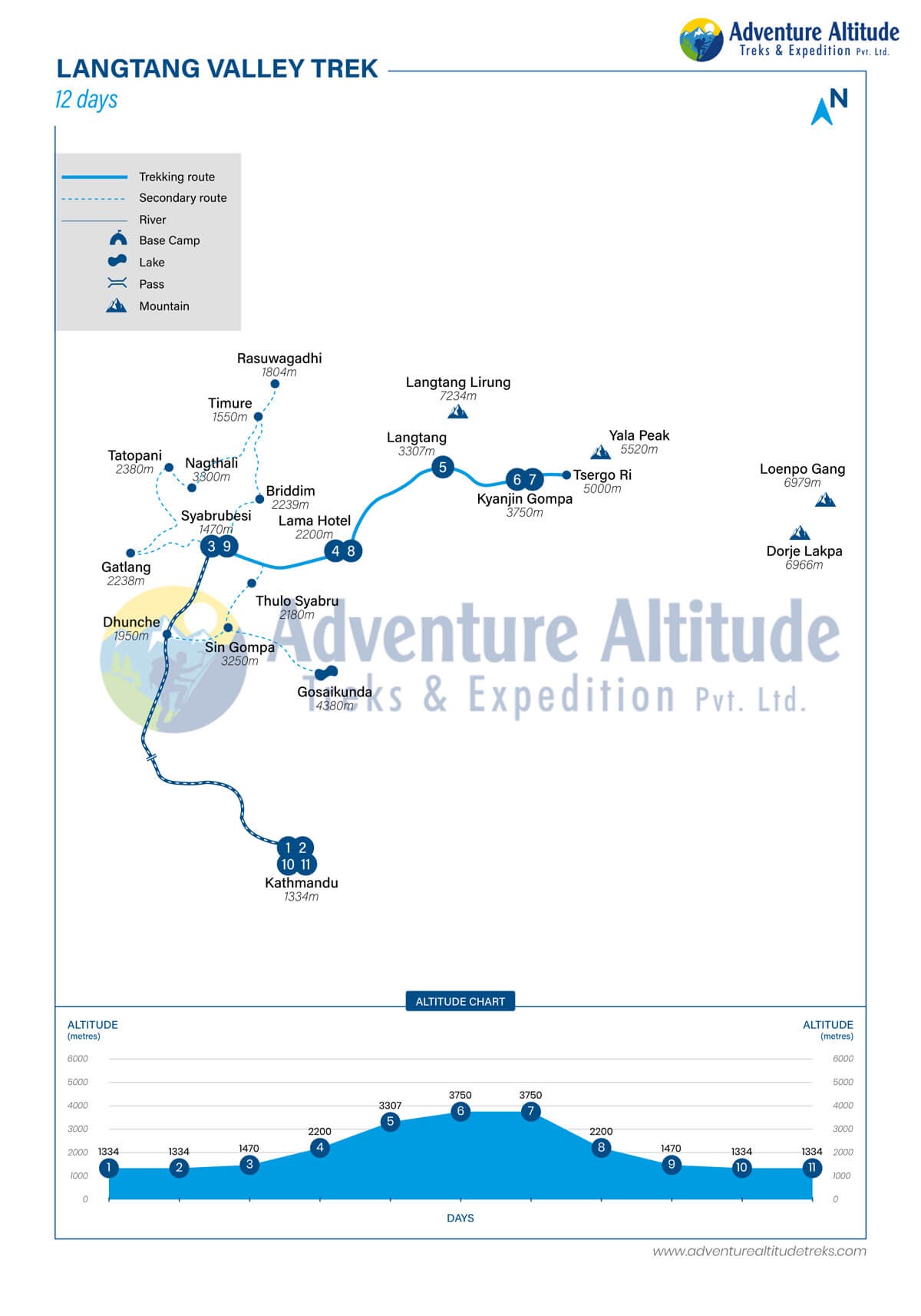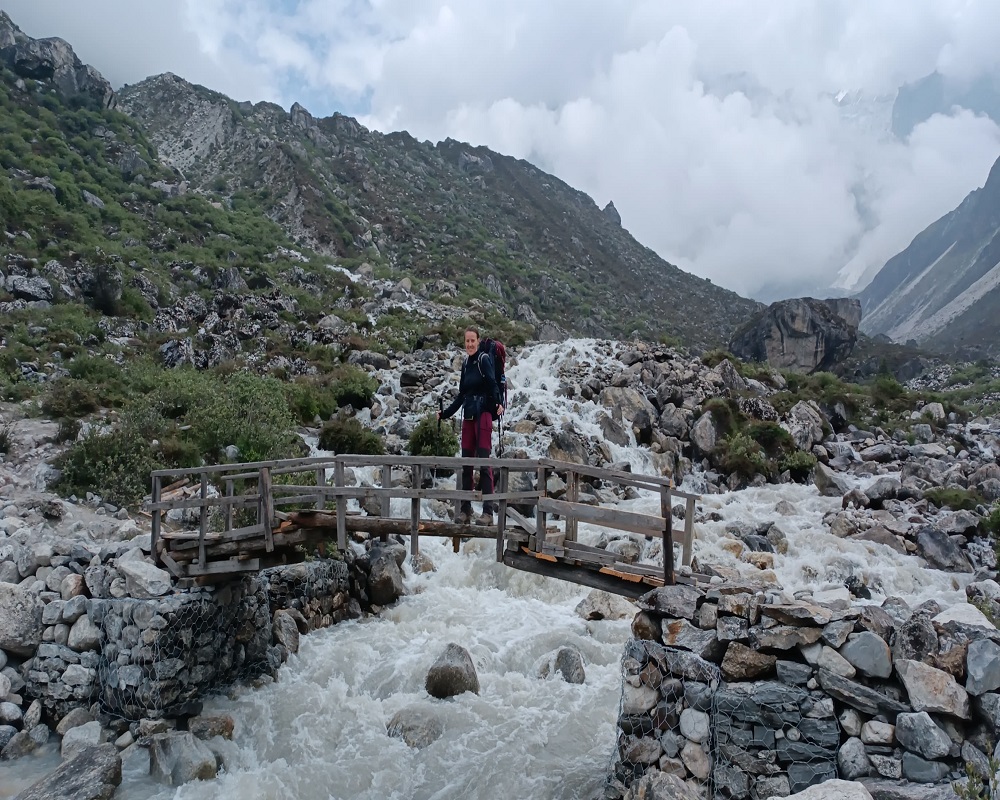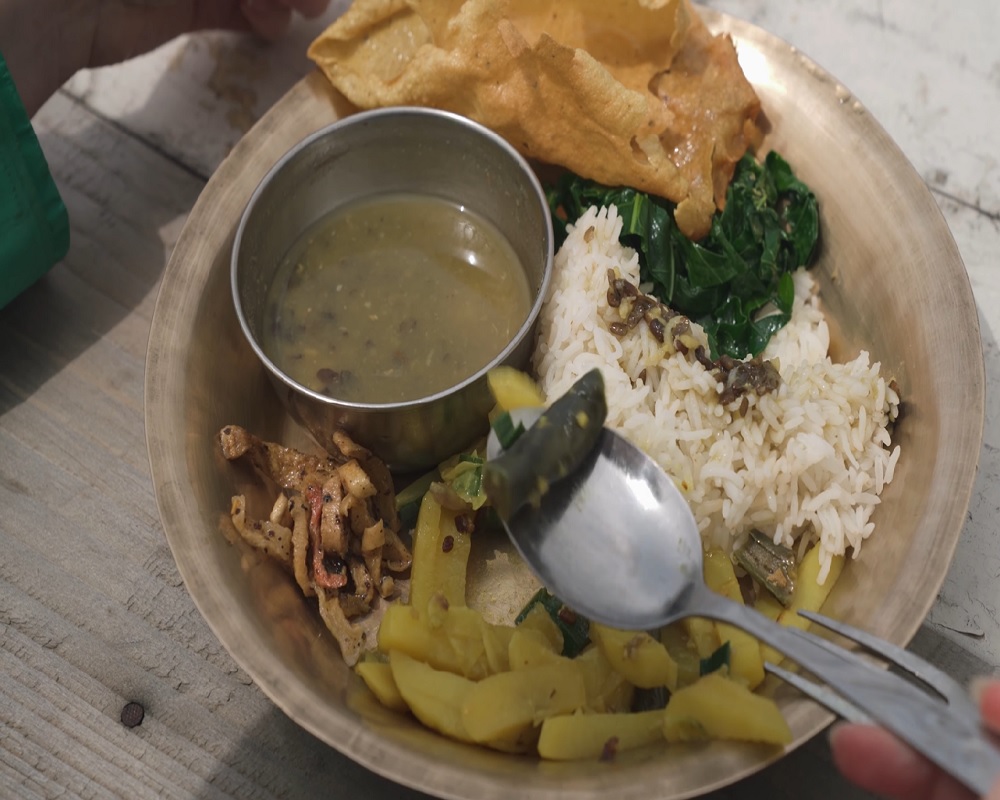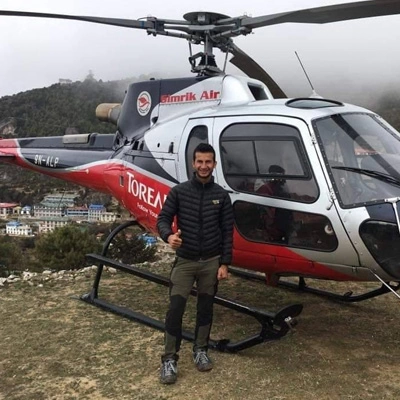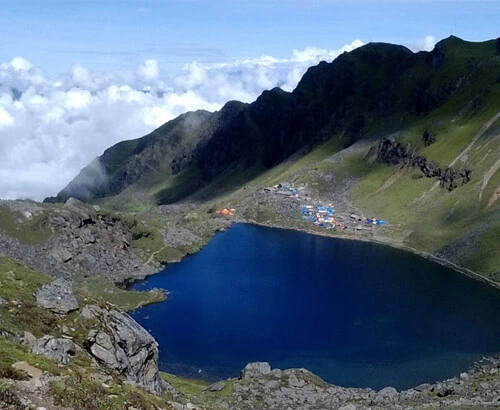The Langtang Valley Trek takes you to the Langtang National Park area, which is one of the most easily accessible parts of Kathmandu. The region is just 137 km and is a just-right mix of nature, cultural know-how, and Himalayas views, without the presence of too much crowd. The hike starts out at Syabrubesi, heading eastwards along the Langtang Valley, past various small villages and teahouse clusters, and ends when you reach Kyanjin Gompa.
Most trekkers take around 6–8 days to cover just the trail, add a few more if you'd like to travel from Kathmandu and back on foot as well. Roughly put, it usually takes 8-10 days in total.
Langtang Valley Trek Overview
The Langtang Valley Trek starts with your arrival at Kathmandu, followed by a scenic drive to Syabrubesi. After a hike to Lama Hotel, the trek begins in earnest as we ascend the Langtang Valley and continue up to Kyanjin Gompa. Spend a full day in Kyanjin Ri for awe-inspiring panoramic views of surrounding peaks. Return via the Lama Hotel to Syabrubesi before driving back to Kathmandu. The trail traverses varied landscapes ranging from evergreen forests and dense chestnut tree orchards to rich alpine meadows, affording distinct glimpses into Tamang and Tibetan culture.
This is an easy trek on good trails following the Langtang Khola through verdant forests of rhododendrons and bamboo forests where we may sight yellow-throated martin, Himalayan black bear, red pandas, wild boar, a whole array of birdlife, among others.
Along the way, trekkers encounter a range of cultural and natural highlights. For instance, stunning forests, including bamboo forests all the way to the suitably named village of Bamboo, are found on the trail. Bamboo is a common teahouse lunch stop for most trekkers. Trekking further will take you to Pairo, another small village with two teahouses and an easily accessible hot spring for a relaxing soak.
The monastery is adorned with vivid prayer flags and many small stupas. One of the major attractions along this trek is definitely a visit to this beautiful monastery. However, during most times in the year, especially after monsoon when monks return from the lower parts after their annual stay there participating in the different festive seasons like Dhud-Chen, it remains closed till late morning on other days as well too, except early-morning hours.
This trek goes through the area damaged by the earthquake in 2015, and you can see how much the local communities are working on rebuilding. We stay at tea houses/lodges run by them as well, so our visit is contributing to keeping this rebuilding going.
This is moderate trekking; it's good for those who will be first in Nepal and/or prefer to stay away from crowded trails. The best combination of some natures plus cultures for the introduction of Himalayan treks.
An optional side trip to Tsergo Ri provides an incredible panoramic view that is kept for the more adventurous trekkers. It can be a tricky climb, especially in snowy conditions, and microspikes are highly advisable.
The best view can be seen throughout, but the weather is unpredictable and can get quite misty pretty fast at the top. Despite these, once you hit the pass at the 5,000 m mark, most people feel triumphant.
Langtang Valley Trek is a beautiful and rewarding trek with a perfect blend of untouched natural treasures and ancient cultural practices. It suits both beginners and moderately experienced trekkers, as the trail itself is relatively easy to follow. In addition, good tea house lodging facilities are available along the great trail in one of Nepal's scenic regions, Langtang.
What Are The Benefits of Langtang Valley Trek Over Other Treks in Nepal?
A number of special advantages make the Langtang Valley Trek outstanding for any person who wants rugged high-altitude experiences associated with a rather relaxed and flexible trekking itinerary.
Diverse Landscapes
The landscapes vary from the lush forests with langur monkeys at the lower parts of the trek to towering mountains topped with snow in the upper valley.
Moderate Difficulty
This is the kind of trek that many more people can do without it feeling excessively challenging, and the views won’t be any less wonderful.
It has a flexible high-altitude experience, with the highest overnight stay being at Kyanjin Gompa; optional day hikes to Kyanjin Ri and Tsergo Ri take you close to 5000m. This gives trekkers the opportunity to acclimate without having to sleep at altitudes.
Less Pressure on Acclimation
Unlike treks such as the Manaslu or Annapurna Circuits, which mandate the crossing of high passes, the Langtang Valley allows trekkers to tailor their high-altitude experiences to how they are feeling at any moment without affecting the overall pattern of the trek.
Easy Adaptation
In case of a problem with altitude during day hikes, it is quite easy to turn back without messing up the main itinerary.
Langtang Valley Trek: The Best acclimatisation hike in 2025/26
The Langtang Valley Trek is a great acclimatization hike, combining some extraordinary experiences with a number of practical benefits for trekkers. You get fantastic views of an up-and-down valley on this hike, with the opportunity to reach higher altitudes through day hike options. You can reach pretty good heights of about 5000 meters while you sleep at a more comfortable height of 3900, which makes it an ideal acclimatization experience.
Perfect for visitors looking to partake in multiple treks across Nepal, the Langtang Valley Trek provides the ideal starting point. It gets your body going for the higher treks in altitude: the Manaslu Circuit, Annapurna Circuit, the Everest Base Camp, or the Everest Three Passes trek. If you do this first, you will find yourself much better acclimatized and prepared for the lower oxygen levels at altitude.
The Langtang Valley Trek not only provides acclimatization but is also a versatile trek. It combines quite easily with other treks in the immediate environs, like the Gosainkunda or the Tamang Heritage Trail, to provide a longer and more varied trek. Added adventure comes from the ascent of Yala Peak on a short camping expedition from Kyanjin Gompa.
By choosing the Langtang Valley Trek for your first Nepal hike, you are not only spoiling yourself with some of the finest mountain views out there but also preparing your body in time for high-altitude adventures in the Himalayas.
What Are The Main Attractions of Langtang Valley Trek?
The Langtang Valley Trek combines natural beauty, cultural experience, and adventure in perfect harmony. The most striking treks lie in one of the most beautiful areas in Nepal. Starting from different landscapes, including lush forests to high-altitude glaciers, with local communities and distinctly watching the Himalayan panoramas, this trek takes you across them all.
Langtang National Park
- Established: 1976
- Area: 1,710 sq km
- Elevation range: 1,000 to 7,245 metres
- Wildlife: red pandas, Himalayan black bears, snow leopards, musk deer
The entire trek serves as the backdrop for the Langtang National Park. The park itself is rich in biodiversity since it comprises quite varied climatic conditions: flora and fauna that exist from subtropical forests at the lower altitudes to temperate forests at middle altitudes and alpine meadows above the treeline, offering continually changing vistas as one goes higher up the valley.
Kyanjin Gompa
- Altitude: 3,800 meters (12,467 feet)
- Key attraction: 400-year-old Buddhist monastery
- Surrounded by peaks: Langtang Lirung, Yala Peak, Naya Kanga
Kyanjin Gompa is one of the beautiful villages that has developed into a base camp for further climbs in the upper Langtang Valley. In the middle of it all is an old monastery, serving with spiritual and cultural enlightenment, with dramatic peaks around in the background setting. Many trekkers use this village as a launch point for day hikes to nearby viewpoints or peaks.
Tserko Ri
- Elevation: 4,984 meters (16,348 feet)
- Trekking time: Usually a day trip from Kyanjin Gompa
- Views: Langtang Lirung, Langshisa Ri, Gyanghempo, Dorje Lakpa, Ganesh Himal
Tserko Ri is one of the most popular side treks, starting from Kyanjin Gompa. It brings some of the most astounding views available in the Langtang region. This vigorous climb offers panorama vistas of surrounding peaks and glaciers, which is just pure bliss—a real highlight of the Langtang Valley Trek.
Langtang Valley
- Location: 19 miles north of Kathmandu
- Key features: Forests, rivers, waterfalls, high-altitude meadows
- Local communities: Tamangs, Sherpas, Gurungs
The Langtang Valley itself forms the hub of this trek, including such varied landscapes that dramatically change while rising upwards. The forests of rhododendrons give place to rocky moraines and display part of the natural beauty of Nepal. Inhabited by different ethnic communities, it offers rich cultural experiences along the way.

Gosaikunda Lake
- Altitude: 4,380 meters above sea level
- Religious significance: Sacred to both Hindus and Buddhists
- Annual festival: Janai Purnima (full moon in July/August)
Although this is not on the main route of the Langtang Valley, Gosaikunda Lake is often added to extended itineraries. This high-altitude lake is steeped in Hindu mythology and is a popular pilgrimage site. Crossing Laurebina Pass adds extra challenges and rewards to trekking in Gosaikunda. If you want to add side trip to Gosainkunda Lake with Langtang Valley Trek go through our package "Langtang Gosaikunda Trek" for more details.
Tamang Heritage Trail
- Focus: Cultural immersion in Tamang villages
- Key attractions: Traditional architecture, costumes, handicrafts
- Additional features: Hot springs, mountain views
Tamang Heritage Trail can be combined with Langtang Valley Trek to get a full experience. This trek is tailored for cultural interaction and, therefore, allows trekkers to experience the unique lifestyle and traditions of the Tamang people.
Yala Peak
- Altitude: 5,520 metres
- Difficulty: Suitable for novice climbers
- Duration: Typically 3-4 days from Kyanjin Gompa
For those looking for a little more excitement, Yala Peak offers a relatively easy introduction to Himalayan mountaineering. Views from the summit are sensational, and the climb makes for a great addition to the Langtang Valley Trek.
Helambu Trek
- Starting point: Sundarijal (near Kathmandu)
- Duration: 5-7 days
- Highest point: Tsergo Ri (4,985m)
The Helambu Trek can be combined with the Langtang Valley Trek for a longer, more varied experience. This route passes through beautiful forests, terraced fields, and traditional villages, offering a gentler trekking experience compared to the higher altitudes of Langtang.
Langtang Glacier
- Location: Base of Langtang Lirung mountain
- Key features: Crystal-clear ice, reflective surfaces
- Surrounding: Rich biodiversity
Although comparatively small, Langtang Glacier presents an excellent view and is the closest a trekker can get to a Himalayan glacier. It is also rich in flora and fauna—therefore, it is just a place for nature lovers.
Langtang Cheese Factory
Products: Variety of organic cheeses
Production methods: Traditional techniques
Impact: Supports local economy and sustainable practices
The Langtang Cheese Factory is the cultural point of interest on the trek. It shows the locals' adopted style of production and offers samples of very fine cheese.

Langtang Valley Trek 10/ 11 Days Cost 2025/26
Langtang Valley Trekking Group Joining Cost
Our Langtang Valley Trek has an attractive group discount price structure so more adventurers can make this incredible journey. For groups of 1 to 5 people, the cost for this trip will be US $799 per person. The more people in the group, the bigger the savings. Groups of 6 to 10 trekkers get a group rate of US $750 per person; groups of 11-40 trekkers receive the best rate of US $699 per person.
This affordable pricing encourages travelers to team together and share this incredible experience of Langtang Region trekking. Our group treks include a certified English-speaking guide, all necessary permits, accommodation in tea houses, all meals during the trek, transportation to and from the trailhead, and farewell dinners in Kathmandu.
No of Trekkers | Price Per Person | |
1 - 5 pax | US $799 | |
6 - 10 pax | US $750 | |
11 - 40 pax | S $699 |
Langtang Valley Private Trek Cost
The private trek, for people who want a more tailored experience, is similarly priced to our group treks. From US $799 per person for groups of 1 to 5, this option ensures you'll always be trekking independently with your group—family, friends, or like-minded travelers. Probably the major plus about a private trek is flexibility in pace, schedule, and experience.
As such, you won't be joining other groups of trekkers, and thus, you can experience the Langtang Valley more personally. Private treks include all services of our group treks—that is, guide services, permits, accommodation, meals, and transportation. This excludes, just as in a group trek, international flights, visa fees, insurance, personal expenses, and gratuities.
Langtang Valley Trek for Students
We understand that the student traveler is a bit more thrifty than the mainstream backpacker, and we try to offer the best value on the Langtang Valley Trek for the adventure-minded, mindful-of-cost young person.
While our base prices are set congruent with group pricing, we offer a discount of 5% to students with a valid identity card. The group and private trek options are made more affordable for students, thus allowing them to take away a lifetime experience with them from the beautiful Langtang region.
Langtang Valley Trek for Seniors
For our senior trekkers above 60, we continue with our regular pricing but include some added services for better support and a safer and more comfortable trek. These are at no extra cost to you and include some of the following: a more relaxed pace, extra intermediate rest time, optional porterage, closer health monitoring throughout the trek, and the option of single rooms whenever possible for overnight stays. It will also ensure that the Langtang Valley Trek is accessible and enjoyable to any age group.
The senior trekkers' package includes everything that lies in our normal trek package: guides, permits, accommodation, meals, and transportation. For the other categories, international air travel, visa fees, insurance, personal expenses, and optional tips should be independently covered.
